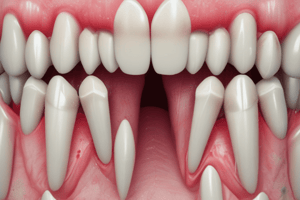Podcast
Questions and Answers
What is the mechanism by which water is attracted into a cyst to raise the internal pressure?
What is the mechanism by which water is attracted into a cyst to raise the internal pressure?
- Epithelial proliferation
- Semi-permeable membrane (correct)
- Increased collagenolysis
- Enhanced bone resorption
Which factor stimulates the proliferation of cells in a cyst to form arcades of epithelium?
Which factor stimulates the proliferation of cells in a cyst to form arcades of epithelium?
- Products of epithelial autolysis
- Bone resorbing factors from the capsule
- Low-grade infection (correct)
- Prostaglandins like PGE2 & PGI2
What contributes to the unremitting growth of the epithelial lining in keratocysts?
What contributes to the unremitting growth of the epithelial lining in keratocysts?
- Mural growth
- Epithelial autolysis
- High mitotic value (correct)
- Peripheral cell division
Which process enlarges a bony cavity by the release of bone resorbing factors from the capsule?
Which process enlarges a bony cavity by the release of bone resorbing factors from the capsule?
How does increased internal pressure within a cyst affect the adjacent bone?
How does increased internal pressure within a cyst affect the adjacent bone?
What prevents attracted fluid from diffusing out of a cyst?
What prevents attracted fluid from diffusing out of a cyst?
Which factor increases the surface area of cyst lining by cell multiplication?
Which factor increases the surface area of cyst lining by cell multiplication?
What stimulates cells known as cell rests of Malassez to proliferate and form arcades of epithelium?
What stimulates cells known as cell rests of Malassez to proliferate and form arcades of epithelium?
Flashcards are hidden until you start studying
Study Notes
Residual Cysts
- Histopathological features are similar to conventional radicular cysts, but may become less inflamed over time
- Cyst wall may eventually be composed of uninflamed collagenous fibrous tissue
- Radiographic appearance: a large residual cyst left behind after extraction of a tooth (e.g. 1st mandibular molar)
Differential Diagnosis
- Lesions to be distinguished from periapical radiolucencies include:
- Periapical granuloma
- Peripaical cemento-osseous dysplasia (early lesions)
Lateral Periodontal Cysts
- An uncommon but well-recognized type of odontogenic cyst
- Occur in the lateral periodontal position
- Inflammatory etiology and diagnosis of collateral OKC are excluded on clinical and histological grounds
- Clinical features:
- Age: 20-60 years, peak in 6th decade
- Sex: Male predilection
Frequency of Epithelial Cysts of Jaws
- Radicular cyst: 5.60%
- Dentigerous cyst: 8%
- Odontogenic keratocyst: 11.60%
- Residual cyst: 4.20%
- Paradental cyst: 18.10%
- Unclassified odontogenic cysts: 52.30%
Radicular Cysts
- Also called apical periodontal cyst
- Most common inflammatory cysts, arising from epithelial residues in the periodontal ligament
- Result from periapical periodontitis following death and necrosis of the pulp
- Can remain behind in the jaws after removal of the offending tooth (residual cyst)
Pathogenesis of Radicular Cysts
- Phase of initiation: rests of Malassez proliferate to form the lining of radicular cyst
- Phase of cyst formation: epithelium proliferates and covers the bare connective tissue surface of the abscess cavity
- Water from the tissue fluid is attracted into the cyst to raise the internal pressure
- Hydrostatic pressure is transmitted to the adjacent bone, leading to bone resorption
- Retention of fluid within the cavity: semi-permeable membrane governs access into the cyst, preventing the escape of certain substances from the contents
Studying That Suits You
Use AI to generate personalized quizzes and flashcards to suit your learning preferences.




